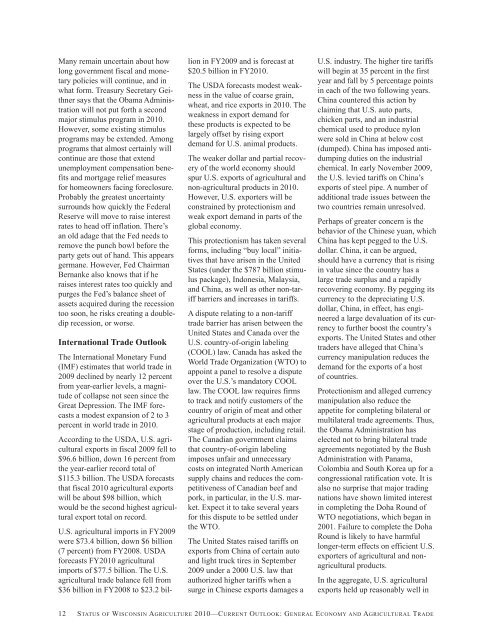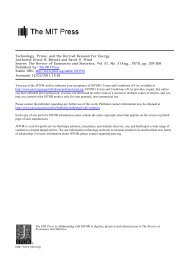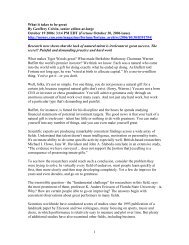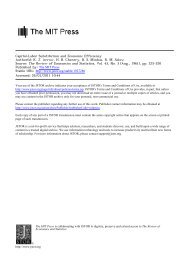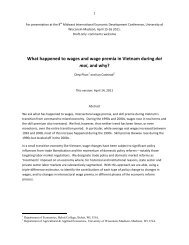Status of Wisconsin Agriculture 2010 - Agricultural & Applied ...
Status of Wisconsin Agriculture 2010 - Agricultural & Applied ...
Status of Wisconsin Agriculture 2010 - Agricultural & Applied ...
Create successful ePaper yourself
Turn your PDF publications into a flip-book with our unique Google optimized e-Paper software.
Many remain uncertain about how<br />
long government fiscal and monetary<br />
policies will continue, and in<br />
what form. Treasury Secretary Geithner<br />
says that the Obama Administration<br />
will not put forth a second<br />
major stimulus program in <strong>2010</strong>.<br />
However, some existing stimulus<br />
programs may be extended. Among<br />
programs that almost certainly will<br />
continue are those that extend<br />
unemployment compensation benefits<br />
and mortgage relief measures<br />
for homeowners facing foreclosure.<br />
Probably the greatest uncertainty<br />
surrounds how quickly the Federal<br />
Reserve will move to raise interest<br />
rates to head <strong>of</strong>f inflation. There’s<br />
an old adage that the Fed needs to<br />
remove the punch bowl before the<br />
party gets out <strong>of</strong> hand. This appears<br />
germane. However, Fed Chairman<br />
Bernanke also knows that if he<br />
raises interest rates too quickly and<br />
purges the Fed’s balance sheet <strong>of</strong><br />
assets acquired during the recession<br />
too soon, he risks creating a doubledip<br />
recession, or worse.<br />
International Trade Outlook<br />
The International Monetary Fund<br />
(IMF) estimates that world trade in<br />
2009 declined by nearly 12 percent<br />
from year-earlier levels, a magnitude<br />
<strong>of</strong> collapse not seen since the<br />
Great Depression. The IMF forecasts<br />
a modest expansion <strong>of</strong> 2 to 3<br />
percent in world trade in <strong>2010</strong>.<br />
According to the USDA, U.S. agricultural<br />
exports in fiscal 2009 fell to<br />
$96.6 billion, down 16 percent from<br />
the year-earlier record total <strong>of</strong><br />
$115.3 billion. The USDA forecasts<br />
that fiscal <strong>2010</strong> agricultural exports<br />
will be about $98 billion, which<br />
would be the second highest agricultural<br />
export total on record.<br />
U.S. agricultural imports in FY2009<br />
were $73.4 billion, down $6 billion<br />
(7 percent) from FY2008. USDA<br />
forecasts FY<strong>2010</strong> agricultural<br />
imports <strong>of</strong> $77.5 billion. The U.S.<br />
agricultural trade balance fell from<br />
$36 billion in FY2008 to $23.2 bil-<br />
lion in FY2009 and is forecast at<br />
$20.5 billion in FY<strong>2010</strong>.<br />
The USDA forecasts modest weakness<br />
in the value <strong>of</strong> coarse grain,<br />
wheat, and rice exports in <strong>2010</strong>. The<br />
weakness in export demand for<br />
these products is expected to be<br />
largely <strong>of</strong>fset by rising export<br />
demand for U.S. animal products.<br />
The weaker dollar and partial recovery<br />
<strong>of</strong> the world economy should<br />
spur U.S. exports <strong>of</strong> agricultural and<br />
non-agricultural products in <strong>2010</strong>.<br />
However, U.S. exporters will be<br />
constrained by protectionism and<br />
weak export demand in parts <strong>of</strong> the<br />
global economy.<br />
This protectionism has taken several<br />
forms, including “buy local” initiatives<br />
that have arisen in the United<br />
States (under the $787 billion stimulus<br />
package), Indonesia, Malaysia,<br />
and China, as well as other non-tariff<br />
barriers and increases in tariffs.<br />
A dispute relating to a non-tariff<br />
trade barrier has arisen between the<br />
United States and Canada over the<br />
U.S. country-<strong>of</strong>-origin labeling<br />
(COOL) law. Canada has asked the<br />
World Trade Organization (WTO) to<br />
appoint a panel to resolve a dispute<br />
over the U.S.’s mandatory COOL<br />
law. The COOL law requires firms<br />
to track and notify customers <strong>of</strong> the<br />
country <strong>of</strong> origin <strong>of</strong> meat and other<br />
agricultural products at each major<br />
stage <strong>of</strong> production, including retail.<br />
The Canadian government claims<br />
that country-<strong>of</strong>-origin labeling<br />
imposes unfair and unnecessary<br />
costs on integrated North American<br />
supply chains and reduces the competitiveness<br />
<strong>of</strong> Canadian beef and<br />
pork, in particular, in the U.S. market.<br />
Expect it to take several years<br />
for this dispute to be settled under<br />
the WTO.<br />
The United States raised tariffs on<br />
exports from China <strong>of</strong> certain auto<br />
and light truck tires in September<br />
2009 under a 2000 U.S. law that<br />
authorized higher tariffs when a<br />
surge in Chinese exports damages a<br />
U.S. industry. The higher tire tariffs<br />
will begin at 35 percent in the first<br />
year and fall by 5 percentage points<br />
in each <strong>of</strong> the two following years.<br />
China countered this action by<br />
claiming that U.S. auto parts,<br />
chicken parts, and an industrial<br />
chemical used to produce nylon<br />
were sold in China at below cost<br />
(dumped). China has imposed antidumping<br />
duties on the industrial<br />
chemical. In early November 2009,<br />
the U.S. levied tariffs on China’s<br />
exports <strong>of</strong> steel pipe. A number <strong>of</strong><br />
additional trade issues between the<br />
two countries remain unresolved.<br />
Perhaps <strong>of</strong> greater concern is the<br />
behavior <strong>of</strong> the Chinese yuan, which<br />
China has kept pegged to the U.S.<br />
dollar. China, it can be argued,<br />
should have a currency that is rising<br />
in value since the country has a<br />
large trade surplus and a rapidly<br />
recovering economy. By pegging its<br />
currency to the depreciating U.S.<br />
dollar, China, in effect, has engineered<br />
a large devaluation <strong>of</strong> its currency<br />
to further boost the country’s<br />
exports. The United States and other<br />
traders have alleged that China’s<br />
currency manipulation reduces the<br />
demand for the exports <strong>of</strong> a host<br />
<strong>of</strong> countries.<br />
Protectionism and alleged currency<br />
manipulation also reduce the<br />
appetite for completing bilateral or<br />
multilateral trade agreements. Thus,<br />
the Obama Administration has<br />
elected not to bring bilateral trade<br />
agreements negotiated by the Bush<br />
Administration with Panama,<br />
Colombia and South Korea up for a<br />
congressional ratification vote. It is<br />
also no surprise that major trading<br />
nations have shown limited interest<br />
in completing the Doha Round <strong>of</strong><br />
WTO negotiations, which began in<br />
2001. Failure to complete the Doha<br />
Round is likely to have harmful<br />
longer-term effects on efficient U.S.<br />
exporters <strong>of</strong> agricultural and nonagricultural<br />
products.<br />
In the aggregate, U.S. agricultural<br />
exports held up reasonably well in<br />
12 STATUS OF WISCONSIN AGRICULTURE <strong>2010</strong>—CURRENT OUTLOOK: GENERAL ECONOMY AND AGRICULTURAL TRADE


